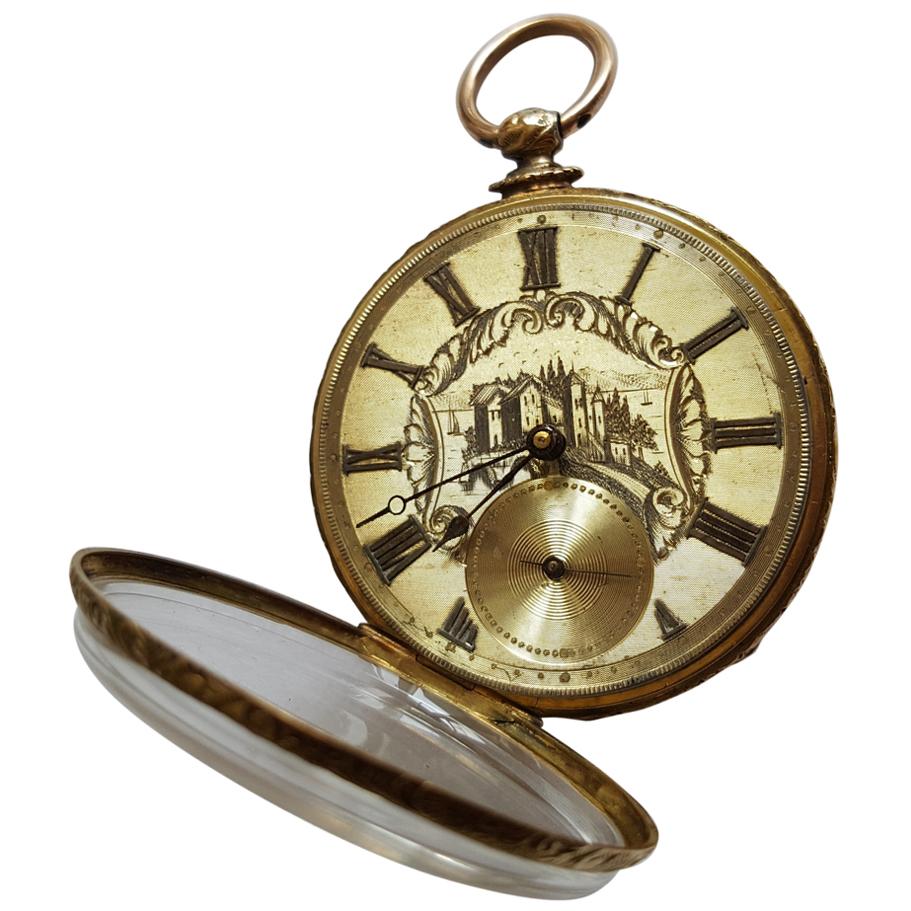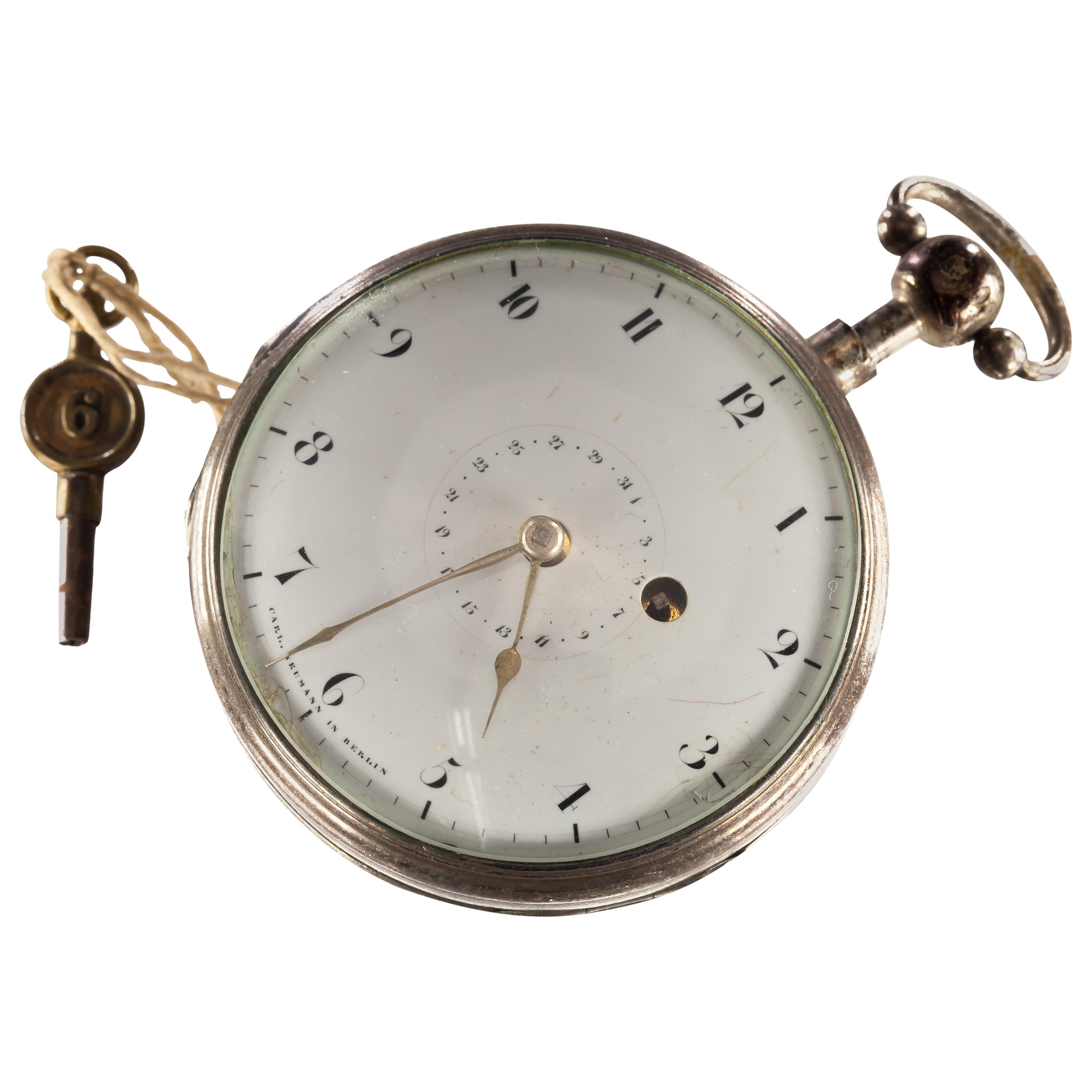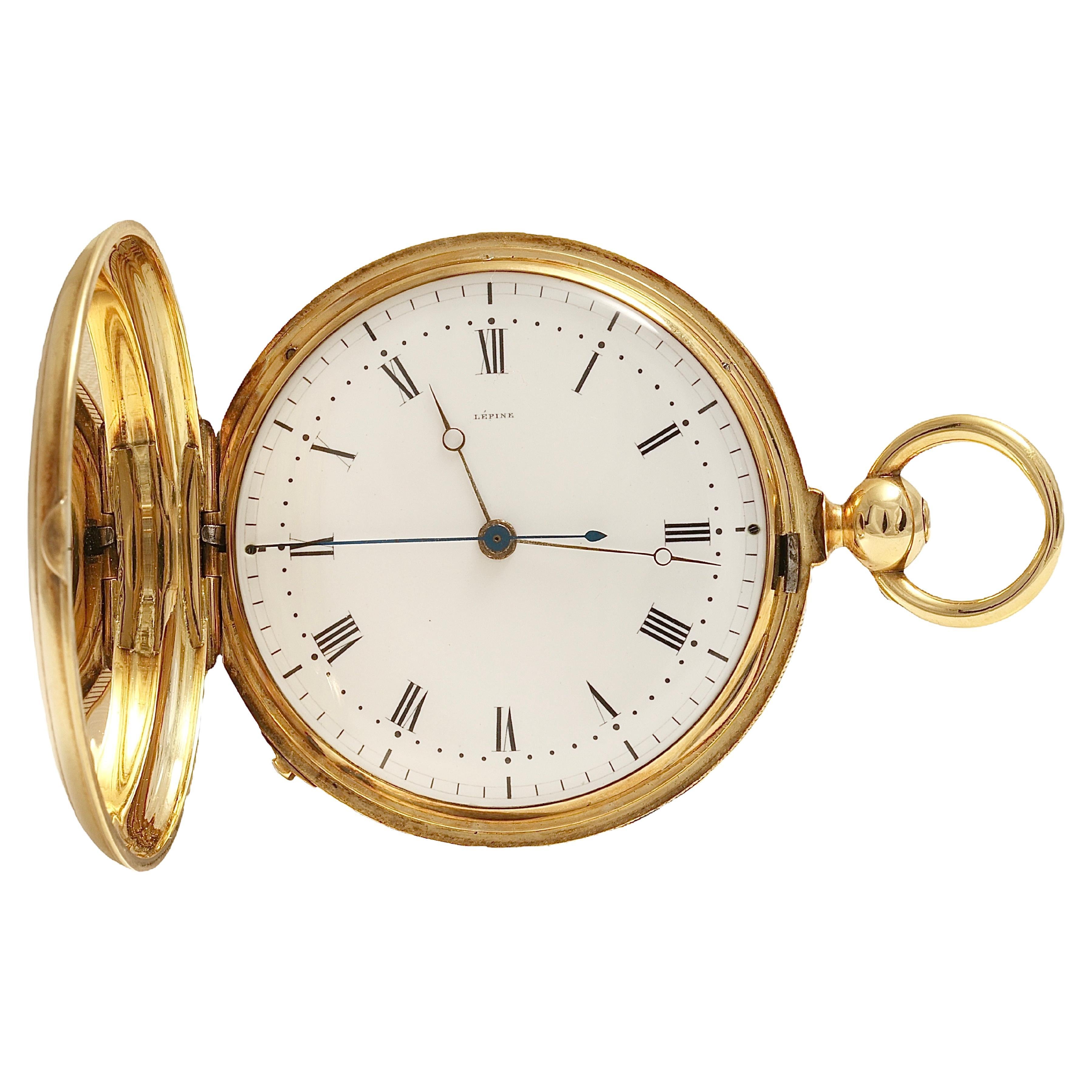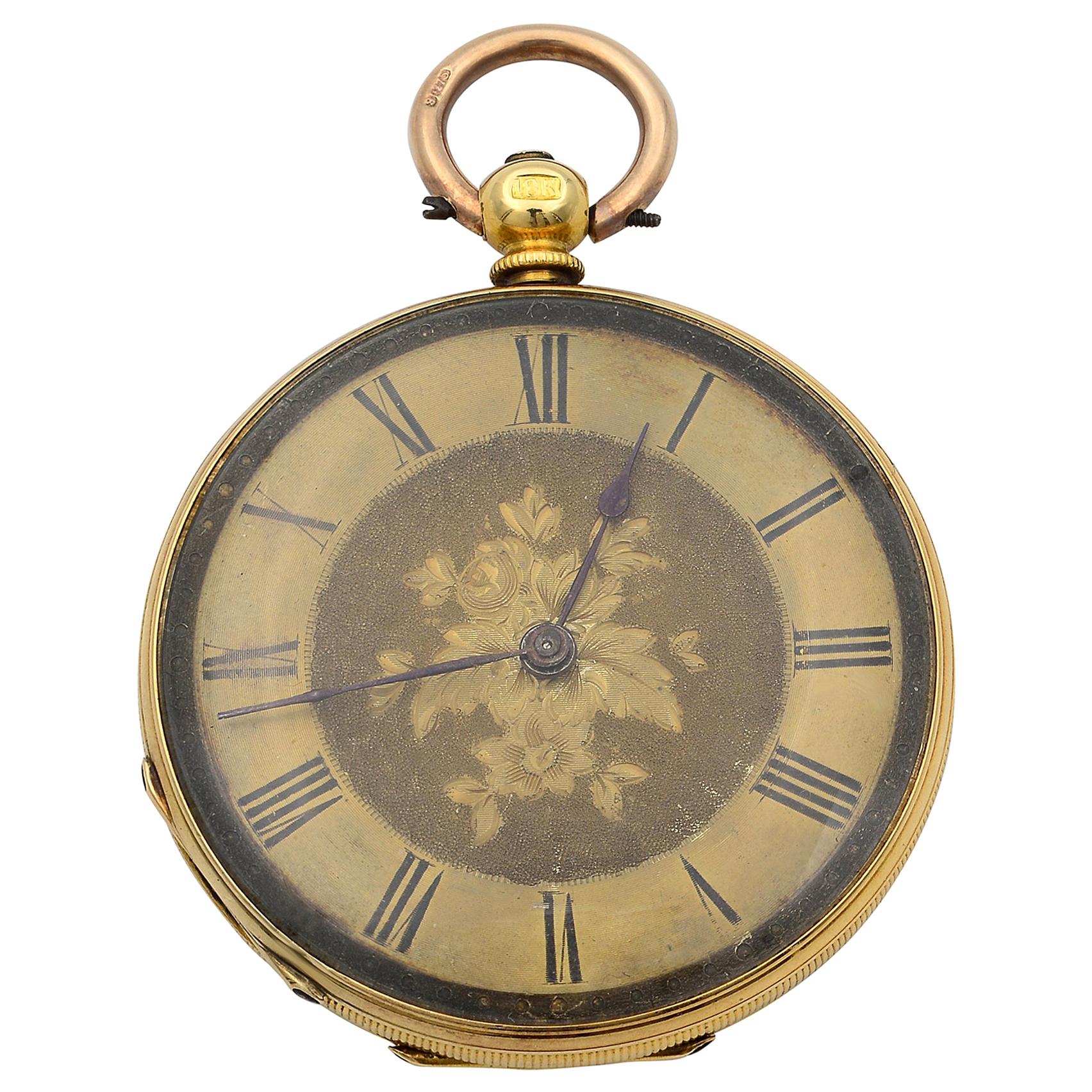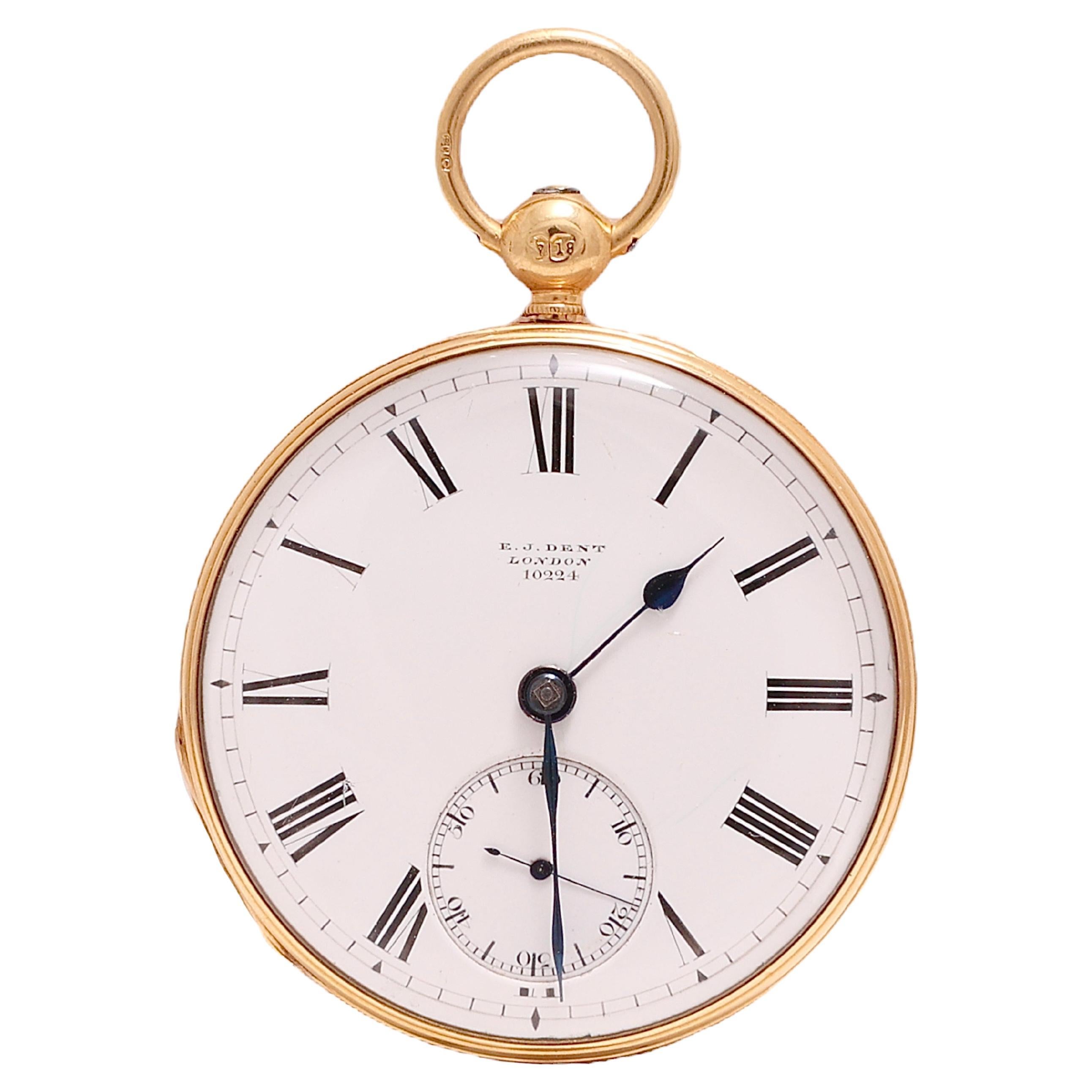Items Similar to 18th-century Lépine Verge movement key wind 18kt gold, a silver pocket watch
Want more images or videos?
Request additional images or videos from the seller
1 of 17
18th-century Lépine Verge movement key wind 18kt gold, a silver pocket watch
About the Item
Antique Late 18th-century Lépine Verge movement key wind 18kt gold, a silver pocket watch with a case decorated with blue enamel, and a silver casket of flower bouquet, set of paste.
Hallmarked on movement, French 18kt. gold standard marks ( eagles's head ), PARIS, Lépine
, 3360.
The timekeeping accuracy of the watches has not been verified. It's recommended that they undergo a service to ensure optimal performance and precision.
Before Jean-Antoine Lépine, there were no watches, just small portable clocks. After his career as watchmaker to French King Louis XV, every fine lady or gentleman wanted a watch in their pocket. His new design transformed the shape of the watch, the process of manufacturing, and the very organization of the watch industry itself. Almost every watch produced over the past century and a half could legitimately be called “Lépine” in its basic design, yet today the term is usually used to refer to the fairly uncommon practice of locating a small seconds subdial at 9:00.
Jean-Antoine Lépine was born near Geneva in 1720 and moved to Paris, where his work brought him life-long fame. He married a daughter of watchmaker André-Charles Caron and became his business partner. He also became part of Caron’s family, including brother-in-law polymath Pierre-Augustin “Beaumarchais” (a watchmaker who funnelled French money to American revolutionaries and wrote the Figaro plays) and sister-in-law artist Marie-Josèphe.
Lépine invented an entirely new way of constructing a watch on a single main plate, dispensing with the fusée and chain and placing the balance on the same plane as the wheel train. Rather than sandwiching the wheels between two plates separated by pillars, Lépine screwed bridges and cocks to the main plate. This allowed for much slimmer watches, improved durability, and made assembly and maintenance easier. The invention was credited for giving French watchmakers an advantage over the then-dominant of English in the mid-19th century.
Lépine’s movements look more modern
Lépine’s arrangement of the wheel train was widely adopted, and the machined main plate became the critical component in watchmaking. Soon, Frédéric Japy established his ebauche factory in Beaucourt, seeding a few basic wheel arrangements to nearly every 19th-century watchmaker. This system of wheels and bridges affixed to a main plate was known at the time as “Lépine” and remains in use today.
Another Lépine invention was equally important. Rather than a Fusée and chain, Lépine used a spring barrel with teeth that meshed directly with the wheels of the movement. Force was regulated by a specially-shaped mainspring rather than the chain, a simplification we continue to rely on today.
Details:
Circa Date: 1750's
Case size: 33 mm
Style: Open Face, swing-out style case
Material: 18kt. Gold and Silver
Decorations: Enamelled case, paste
Dial Colour: White
Dial: White enamel
Numerals: Roman Numerals
Hands: Filigree Hands.
Setting: Key Wind/Key Set
Escapement: Lépine
Signed: Yes.
Dimensions:
Size: 4.8 x 3.3 x 1.7 cm
Weight: 29 grams
Condition: This timepiece is pre-owned and shows signs of wear. It is missing a button, and the dial has suffered damage to the enamel and numerals, as well as a hairline between 3 and 4 o'clock. Additionally, there is a loss of enamel on the back and some paste stones are missing.
- Case Material:
- Weight:29 g
- Case Shape:Round
- Place of Origin:
- Period:1750-1759
- Date of Manufacture:1750's
- Condition:Wear consistent with age and use. Minor losses.
- Seller Location:Braintree, GB
- Reference Number:1stDibs: LU929322231002
About the Seller
4.9
Gold Seller
These expertly vetted sellers are highly rated and consistently exceed customer expectations.
1stDibs seller since 2017
139 sales on 1stDibs
Typical response time: 2 hours
- ShippingRetrieving quote...Ships From: Braintree, United Kingdom
- Return PolicyA return for this item may be initiated within 14 days of delivery.
More From This SellerView All
- Patek Philippe 18kt. yellow gold Gondolo open-face pocket watchBy Patek PhilippeLocated in Braintree, GBPatek Philippe 18kt. yellow gold Gondolo open-face pocket watch. Made in Switzerland, Circa 1900's Dial has been signed Patek Philippe & Co. Genève with a sub-second dial signed abo...Category
Antique Early 1900s Swiss Pocket Watches
MaterialsYellow Gold
- Cartier Art Deco period 18kt yellow gold open-face circular EWC movement pocketBy CartierLocated in Braintree, GBCartier Art Deco period 18kt yellow gold open-face circular EWC movement pocket watch. The rear side has an engraved family crest. The movement is signed European Watch and Clock ...Category
Vintage 1920s French Art Deco Pocket Watches
MaterialsYellow Gold
- Patek Philippe Art Deco period 18kt. yellow gold open-face pocket watchBy Patek PhilippeLocated in Braintree, GBPatek Philippe Art Deco period 18kt. yellow gold open-face pocket watch. Made in Switzerland, Circa 1930's Details: Case diameter: 42 mm Case shape: Round Movement: Manual wind,...Category
Vintage 1930s Swiss Pocket Watches
MaterialsYellow Gold
- Antique 15kt gold open-face pocket watchLocated in Braintree, GBAntique 15kt gold open-face pocket watch. Made in England, London, Circa 1900-1910 Fully hallmarked 15KT Gold with London Import Hallmarks. The timekeeping accuracy of the watches h...Category
Antique Early 1900s British Pocket Watches
MaterialsGold, 15k Gold
- Victorian 18 Karat Gold Pocket Watch Key/Pendant, featuring Leda and the swanLocated in Braintree, GBThis exquisite Victorian pocket watch key/pendant is crafted from 18k yellow gold and adorned with a meticulously carved coral design. The pendant showcases neoclassical scenes on bo...Category
Antique 1880s British Victorian Pocket Watches
MaterialsGold, 18k Gold
- Dunhill 18 Karat Yellow Gold Centenary Pocket WatchBy DunhillLocated in Braintree, GBDunhill 18kt. yellow gold Centenary Pocket Watch Limited Edition: 15/25 Made in Switzerland, Circa 2000 Movement: Mechanical hand winding Case diameter: 51 mm Watch Case Material: 18...Category
Early 2000s Swiss Pocket Watches
MaterialsYellow Gold
You May Also Like
- 18kt Vintage Early 19th Century Gold Pocket Watch, Key Wind, Working, 40mmLocated in Rancho Santa Fe, CA18kt Yellow Gold Vintage Early 19th Century Gold Pocket Watch. Key Wind and It's Working! 40mm Case, Guilloche Face, accented with an image of a castle with a bridge over water...Category
Antique 1840s English Pocket Watches
MaterialsGold
- Carl Neumann of Berlin Silver Key-Wind Pocket Watch Intricate MovementLocated in Sherman Oaks, CAGorgeous Antique Pocket Watch by Carl Neumann of Berlin Key-Wind Movement Intricate Filigree Detail in Movement Silver Case Diameter of Case = 55 mm Thickness of Case = 21 mm Total Mass = 125.8 grams...Category
Antique 19th Century German High Victorian Pocket Watches
MaterialsSilver
- Verge Crown Wheel Key Winding 18K Yellow Gold Ornate Pocket WatchLocated in Washington Depot, CTVerge Crown Wheel Key Winding 18K Yellow Gold Ornate Pocket Watch Approx. 48 mm in diameter, 18 mm thick Stamped SH JW with English Gold Hallmarks inside the case. Date mark of F with square box around it. 61.3 dwt / 95.4g The verge (or crown wheel) escapement is the earliest known type of mechanical escapement, the mechanism in a mechanical clock that controls its rate by allowing the gear train to advance at regular intervals or 'ticks'. Its origin is unknown. Verge escapements were used from the late 13th century until the mid 19th century in clocks and pocketwatches. The name verge comes from the Latin virga, meaning stick or rod.[1] Its invention is important in the history of technology, because it made possible the development of all-mechanical clocks. This caused a shift from measuring time by continuous processes, such as the flow of liquid in water clocks...Category
Antique Mid-19th Century English Pocket Watches
Materials18k Gold, Yellow Gold
- 18 Kt Yellow Gold Lepine Pocket Watch, Second Morte, Double Barrel, CollectorLocated in Antwerp, BE18 Kt Solid Yellow Gold Lépine pocket watch Second Morte & Double Winding Barrel, Chronograph in Amazing Collectors Condition Function : Seconde Morte with Stop function which was used as chronograph seconds counter Movement : Mechanical Manual Winding with Double Barrel Winding !!!!!!!!!!! Dial : Enamel Case: 48 mm, thickness 11.5 mm Total weight: 97.2 gram / 3.430 oz / 62.5 dwt Jean-Antoine Lépine (alternatively spelled L’Pine, LePine, Lepine, L’Epine, born Jean-Antoine Depigny; 18 November 1720 – 31 May 1814) was a French watchmaker. He contributed inventions which are still used in watchmaking today and was amongst the finest French watchmakers, who were contemporary world leaders in the field.[1] Beginnings and appointment as clockmaker to the King Since his childhood the horologist showed an inclination towards mechanical, beginning his horological career and making fast progress, in particular, under the direction of Mr. Decroze, manufacturer of Saconnex watches,[2] in the suburbs of Geneva (Switzerland). He moved to Paris in 1744 when he was 24 years of age, serving as apprentice to André-Charles Caron (1698–1775), at that time clockmaker to Louis XV. In 1756 he married Caron's daughter and associated with him, under "Caron et Lépine", between 1756 and 1769.[3] Watches with a signature Caron et Lépine or equivalent are not known; apparently Lépine was independent to a certain extent. As early watches were not numbered, it is uncertain when Lépine began to sign watches with Lépine à Paris on the movement and partially L'Epine à Paris on the dial. On 12 March 1762, he became maître horloger (master horologist) and probably since that year he was teacher of Abraham-Louis Breguet, to whom he had a business relation over many years. In the Breguet archive many watches are recorded as delivered by Lépine. In 1765 or 1766 (precise date not known), he was appointed Horloger du Roi (Clockmaker to the King). In 1766 he succeeded Caron, and appeared on the list of Paris clockmakers of that year as Jean-Antoine Lépine, Hger du Roy, rue Saint Denis, Place Saint Eustache. Ten years later, in 1772, he established himself in the Place Dauphine; in 1778-1779, Quai de l’Horloge du Palais; then in the rue des Fossés Saint Germain l’Auxerrois near the Louvre in 1781; and finally at 12 Place des Victoires in 1789. In 1782, his daughter Pauline married one of his workmen, Claude-Pierre Raguet (1753–1810), with whom he formed a partnership in 1792. He was also associated for a certain period with the philosopher Voltaire, at his watch manufactory set up in 1770 at Ferney. It is not known the exact role he played in the Ferney Manufacture royale, either technical director and/or associate. However, most ebauches for his watches were made there, at least between 1778 and 1782. An unsigned memoir of 1784 reports that Lépine stayed in Ferney for 18 months and that he had watch movements made there with a value of 90,000 livres a year. As a clock and watchmaker to Louis XV, Louis XVI and Napoleon Bonaparte, Lépine's creations were well respected and in demand.[3] 1764/65: Invention of the revolutionary Lépine calibre Lepine Caliber IIA with Quarter Repeater Complication shared with Abraham Breguet Lepine Cuvette Lepine Caliber IIA with Quarter Repeater. Also made by Lepine for Breguet watches. Around 1764/65, he devised a means of manufacturing a pocket watch that could be thinner, favouring the onward quest for further miniaturization. His radical design broke with a 300-year tradition and ushered in the age of precision timekeeping, the modern pocket...Category
Antique 19th Century French Artisan Pocket Watches
MaterialsYellow Gold
- 18 Karat Yellow Gold Mechanical Wind Movement Antique Pocket 34.7g WatchLocated in New York, NYThis pre-owned Non-Branded D&D 18556 is a beautiful Unisex timepiece that is powered by mechanical (hand-winding) movement which is cased in a yellow gold case. It has a round shape ...Category
20th Century Unknown Pocket Watches
- 18 Kt Gold E.J Dent London, Yellow Gold, Open Face Verge Pocket watchLocated in Antwerp, BEE.J Dent London, Yellow Gold Open Face Verge Pocket watch Case: 18 Kt Solid Yellow Gold Diameter 45.5 mm, thickness 12.2 mm Total weight: 68.9 gram / 2...Category
Antique 19th Century British Artisan Pocket Watches
Materials18k Gold, Yellow Gold
Recently Viewed
View AllMore Ways To Browse
Art Deco Ladies Pocket Watch
The Dueber Watch Co
Erotic Automaton
Patek Hourglass
Rolex Imperial
Rotherham Pocket Watch
Touchon Watch
Waltham Colonial Series
Waltham Octagon Gold Pocket Watch
Waltham Octagon Pocket Watch
Waltham Repeater
Watches Remontoir Cylindre 10 Rubis
17 Jewels Incabloc Pocket Watch
18 K Hunter Pocket Watch
Acme Lever Watch
Arnex Watch
Arnold Adams
Arnold Lever
